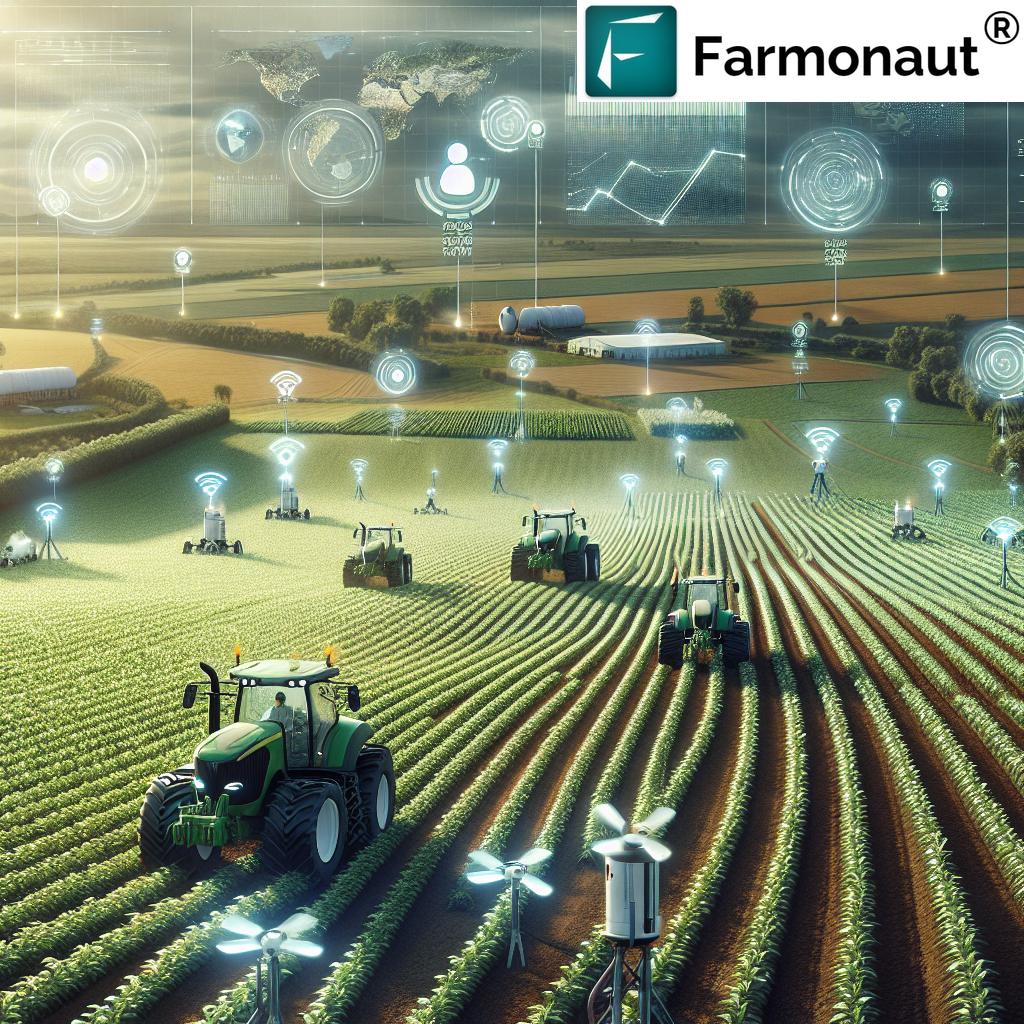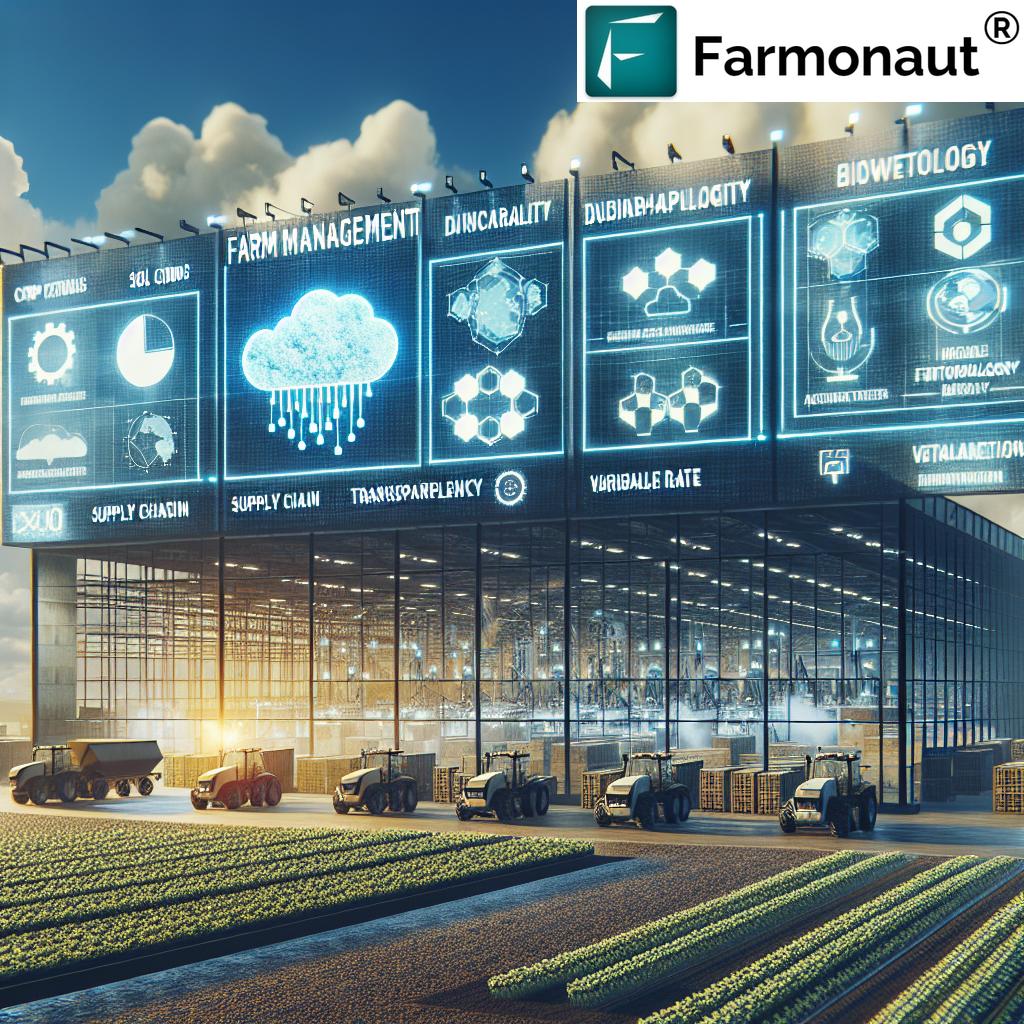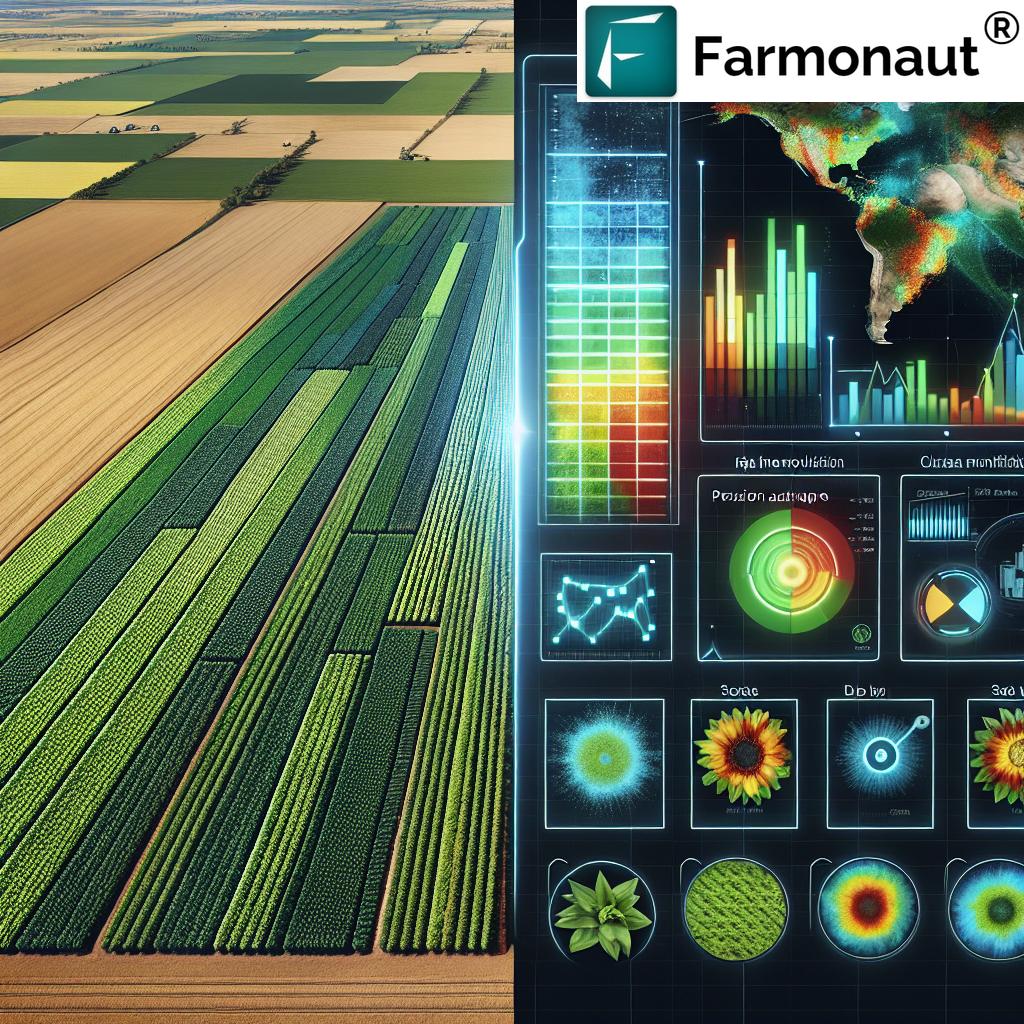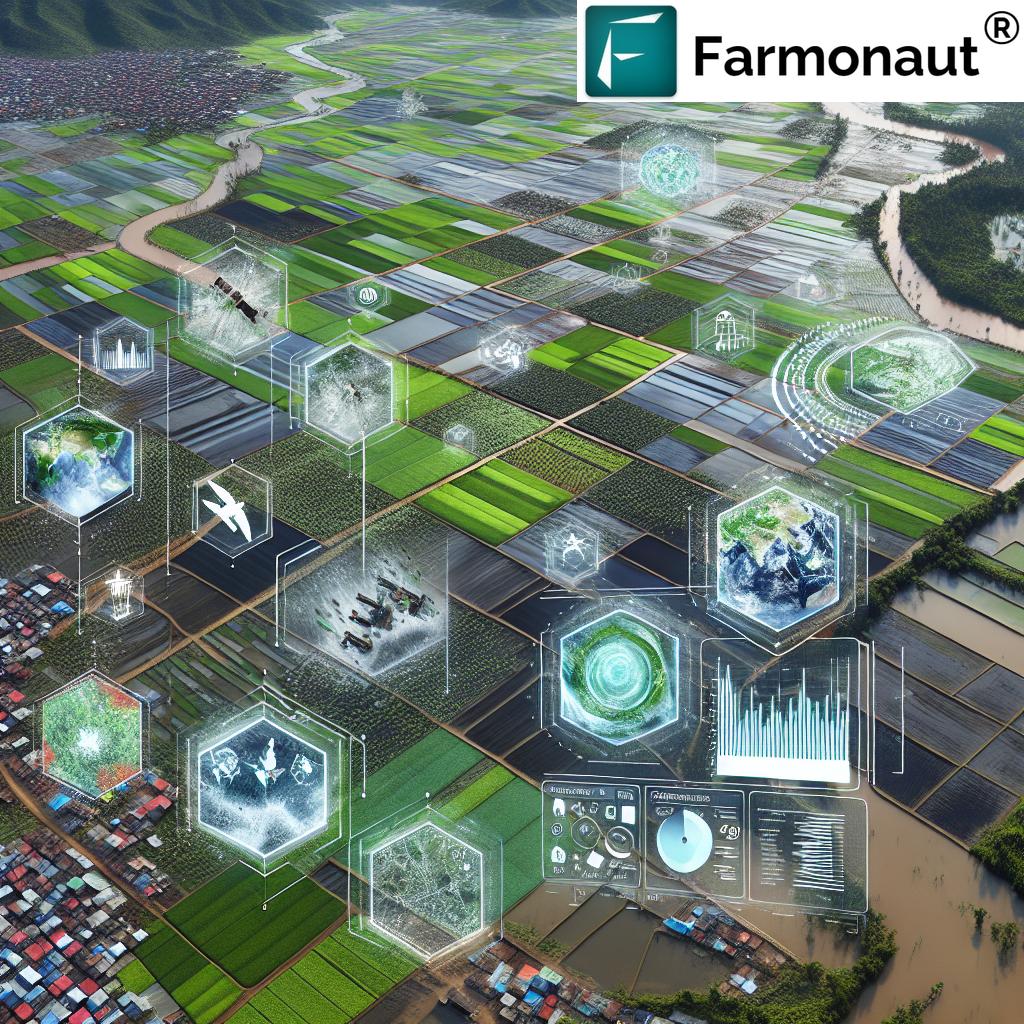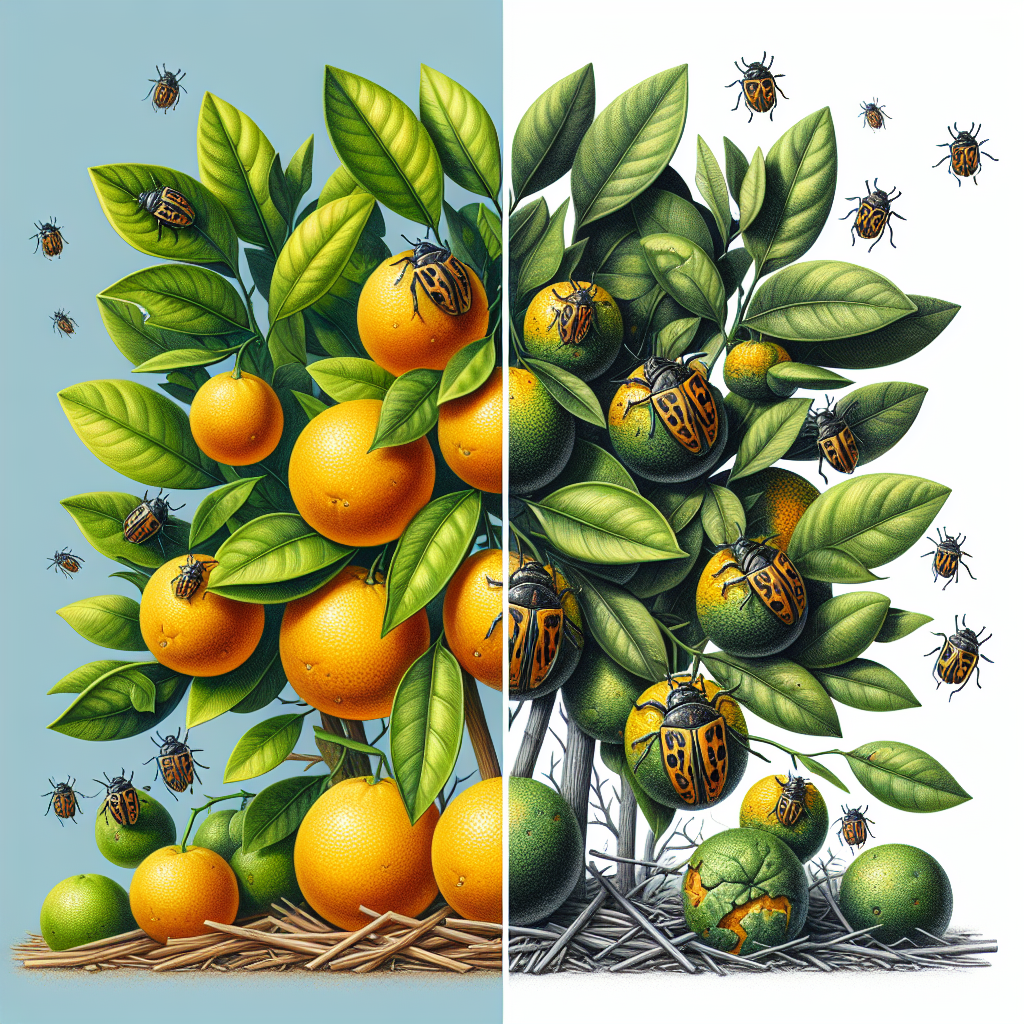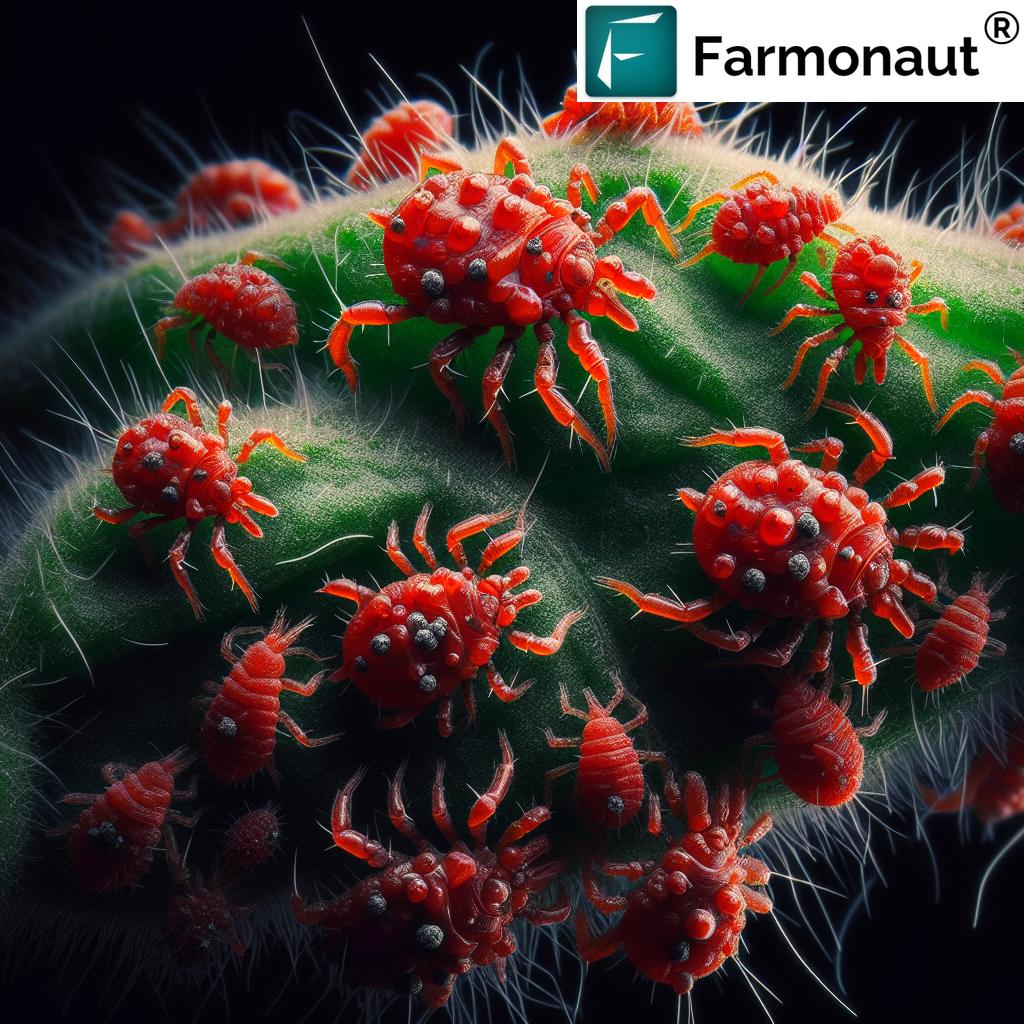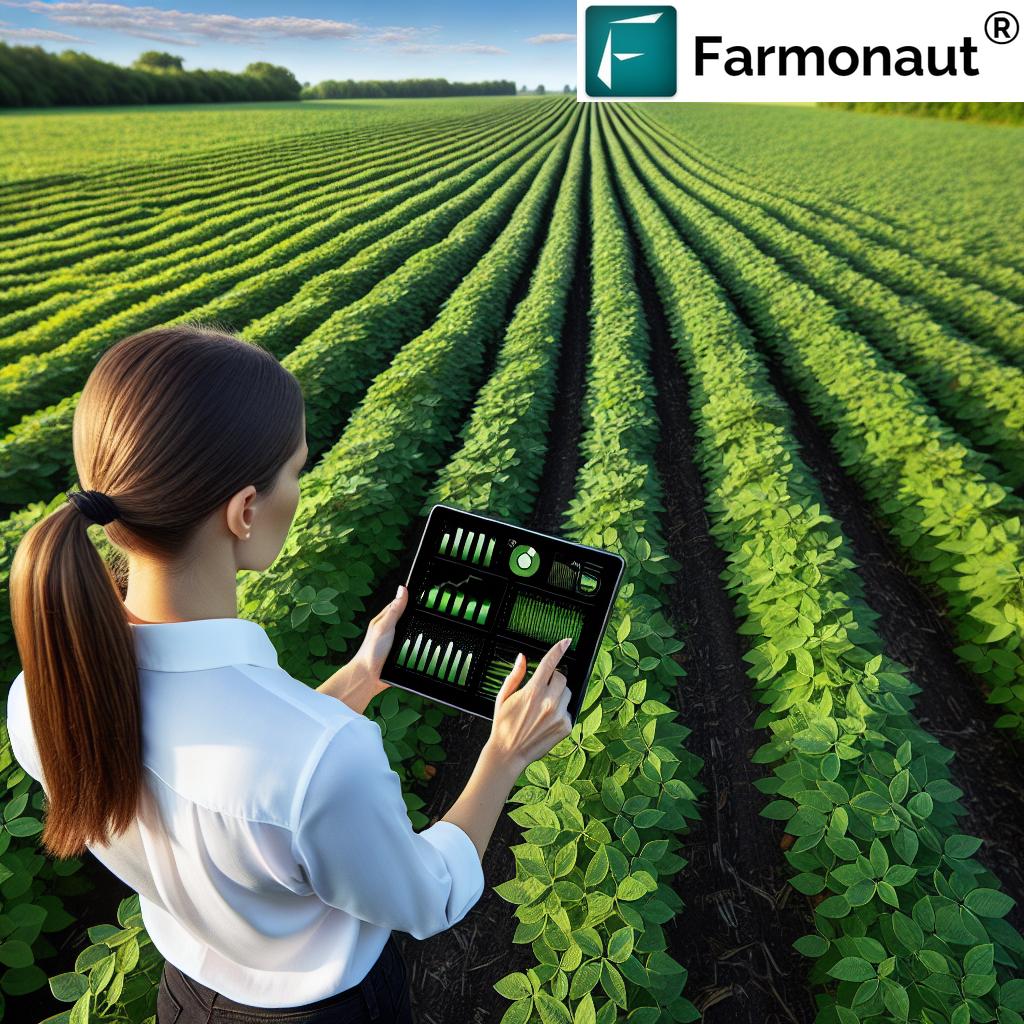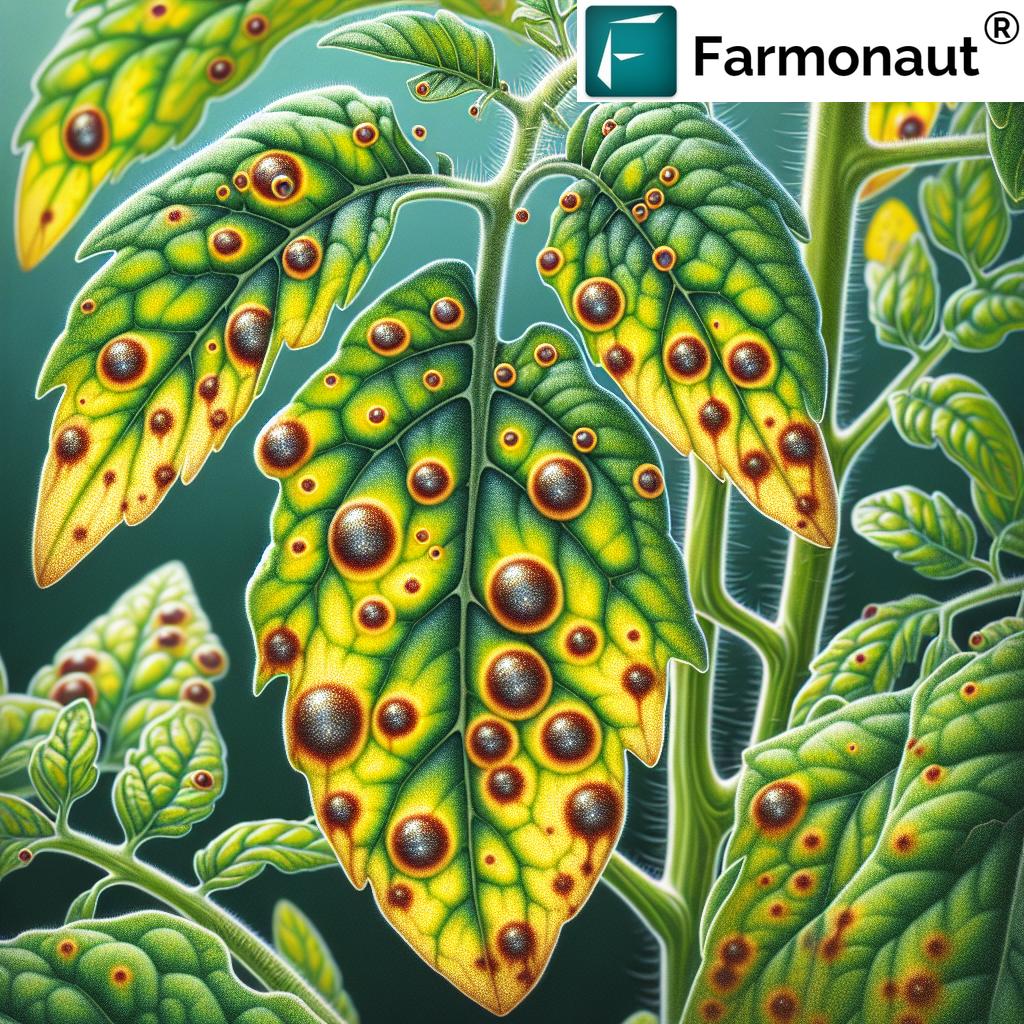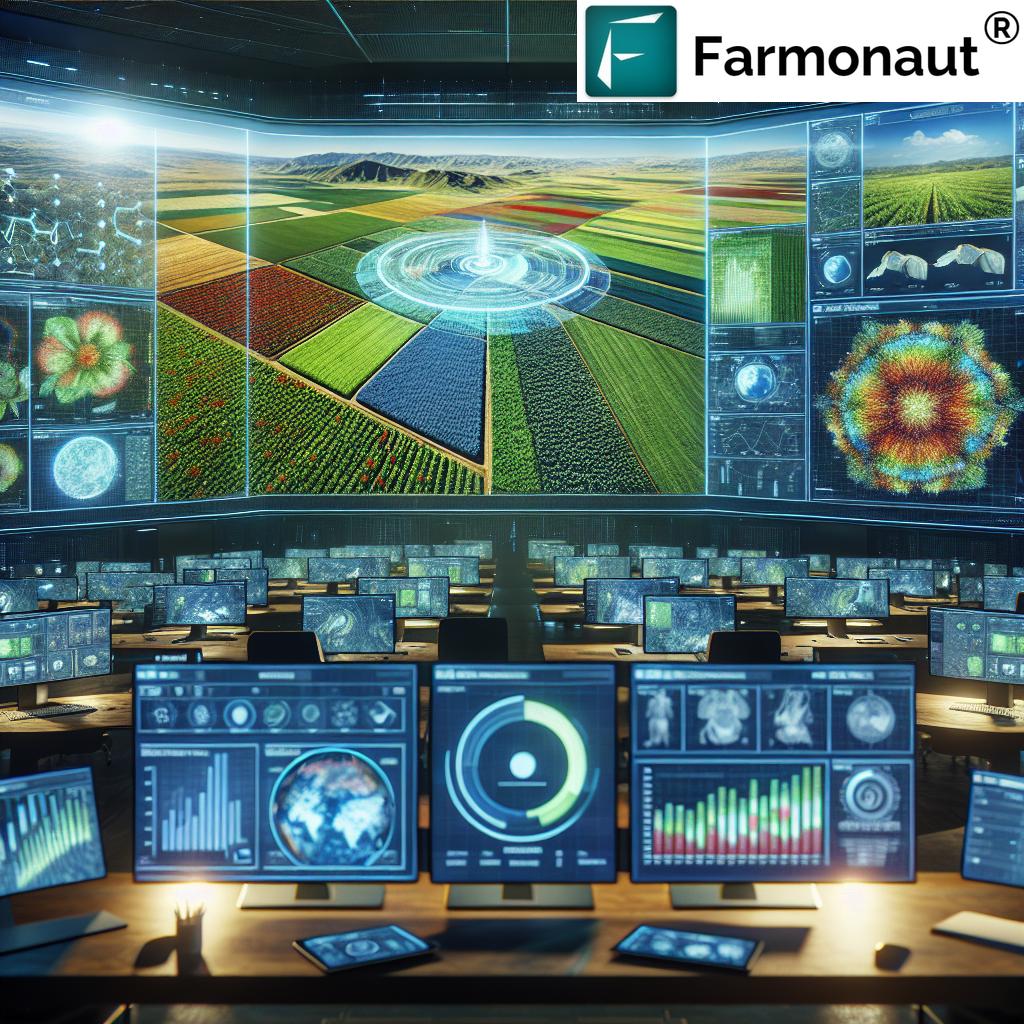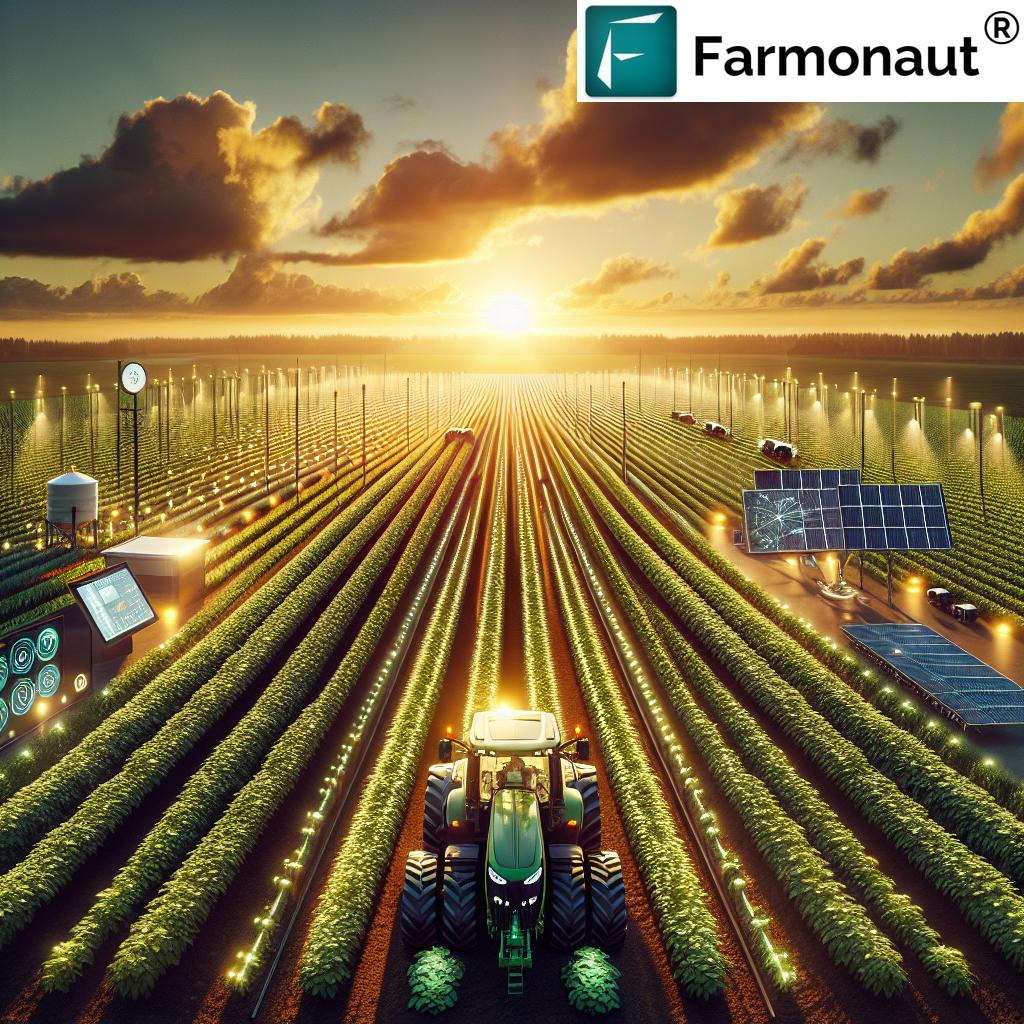Precision Agriculture Trends: 2025 Yield Innovations
Meta Description: Precision agriculture in 2025 is transforming farming with AI, IoT, robotics, and other cutting-edge innovations to optimize crop yields, resource efficiency, and sustainability worldwide.
- Introduction
- Did You Know?
- Autonomous and Electric Agricultural Machinery
- Integration of AI and Machine Learning in Agriculture
- Utilization of Drones and Remote Sensing
- IoT and Sensor Integration in Farming
- Variable Rate Technology in Agriculture
- Blockchain for Supply Chain Transparency
- Biotechnology and Precision Breeding
- Agricultural Robotics: Automation for Productivity
- Nanotechnology in Crop and Soil Health Management
- Cloud-Based Farm Management Software
- Did You Know?
- Comparative Overview: Tech Impact on Yields & Efficiency
- Farmonaut: Satellite-Driven Precision Agriculture Solutions
- Frequently Asked Questions (FAQs)
- Conclusion
Introduction: Precision Agriculture’s Transformative Journey to 2025
The agricultural sector is entering an era defined by automation, advanced analytics, and technology-driven resource management. Known as precision agriculture (or precision farming), this transformative approach integrates cutting-edge technologies to optimize crop yields, enhance resource efficiency, and promote environmental sustainability. By integrating data from satellite imagery, IoT sensors, drones, AI, and other emerging solutions, modern farms are becoming smarter, more connected, and infinitely adaptable.
As of June 2025, several trends are converging to shape the future of agriculture—from autonomous machinery and AI-driven analytics to blockchain-backed traceability and sustainable resource management. In this in-depth blog, we’ll explore these innovations, explain their impact on yields and sustainability, and provide a comparative overview that empowers you—whether you’re a farmer, agribusiness, or tech aficionado—to make informed decisions in this evolving landscape.
1. Autonomous and Electric Agricultural Machinery: Redefining Farm Operations
The adoption of autonomous farm machinery and electric equipment is drastically transforming how we approach farming operations. Machines such as the latest autonomous tractors introduced by leading companies are revolutionizing productivity. These tractors are equipped with high-precision GPS modules, advanced sensors, and sophisticated AI systems, making them capable of performing critical tasks—from planting and fertilizing to harvesting—with minimal human intervention.
- Operational efficiency: Autonomous vehicles increase coverage, consistency, and the pace of field activities, allowing 24/7 operations under optimal conditions.
- Lower costs: The need for on-site labor significantly reduces, while reduced operating expenses are achieved through superior efficiency and the elimination of common human errors.
- Electric machinery: Electric tractors and hand-held tools are on the rise, contributing to reduced carbon emissions—limiting environmental impact and supporting sustainability goals.
Example Trends: Fully electric harvesters, autonomous sprayers with adaptive resource allocation, and “robot fleets” are becoming integral for large and mid-size farms. With real-time data integration, autonomous systems dynamically adjust to variable soil and crop conditions.
2. Integration of Artificial Intelligence and Machine Learning in Agriculture
The combination of AI in agriculture and machine learning (ML) is propelling precision farming to new levels. AI-driven systems can analyze vast amounts of data from various sources, including weather stations, soil sensors, and high-resolution satellite imagery.
- Data-driven decisions: AI models provide actionable insights on crop health, soil conditions, and optimal planting times (based on climate and resource availability).
- Predictive analytics: Advanced algorithms can predict crop yields, identify pest infestations, and flag issues (e.g., nutrient deficiencies), enabling precise interventions and risk reduction.
- Customized management: AI-powered advisory tools—such as the Jeevn AI system from Farmonaut—deliver real-time recommendations for sustainable resource allocation and optimized productivity.
This integration of artificial intelligence is at the forefront of the agricultural revolution, minimizing guesswork, optimizing decisions, and aligning with farm-specific goals.
Farmonaut’s Jeevn AI Advisory System harnesses satellite and field data to deliver tailored guidance, covering weather forecasts, soil health, and actionable crop management tips. Learn more on our app.
3. Utilization of Agricultural Drones and Remote Sensing for Enhanced Crop Monitoring
Drones in agriculture are revolutionizing how farmers monitor crop health and assess soil conditions. Agricultural drones and remote sensing combine high-resolution imaging with advanced sensors to capture real-time spatial data across entire fields.
- Crop assessment: Drones equipped with multispectral cameras help identify pest infestations, disease outbreaks, and areas with nutrient deficiencies—often invisible to the naked eye.
- Precision spraying: Automated drones apply fertilizers and pesticides only where needed, which reduces resource waste and minimizes environmental impact.
- Early detection: Satellite and drone-based remote sensing enables early interventions to prevent yield losses.
The result? Higher productivity, improved resource efficiency, and safer, more sustainable farm management.
4. IoT in Farming: Real-Time Monitoring and Data Integration
The Internet of Things (IoT) and sensor integration represent the connective tissue of modern precision agriculture. IoT devices deployed throughout farms collect and transmit continuous data on:
- Soil moisture levels and nutrient content
- Ambient weather and environmental conditions
- Crop growth status and stress indicators
These technologies empower farmers to make real-time interventions—such as adjusting irrigation or scheduling fertilizer application—and help reduce water consumption by up to 50%. IoT in farming also facilitates automated resource allocation, leading to increased sustainability and yield stability.
By integrating IoT-driven solutions with cloud-based analytics, we support scalable, affordable, and data-centric resource management for farms of all sizes.
5. Variable Rate Technology in Agriculture: Precision Input Application
Variable Rate Technology (VRT) is a groundbreaking solution that enables precision application of water, fertilizers, and pesticides. VRT systems use advanced sensors, data analysis, and sometimes AI models to assess specific soil conditions and crop health within each field zone.
- Resource efficiency: Inputs are used only where and when needed, lowering operating costs and mitigating environmental risks.
- Productivity: By tailoring interventions to in-field variability, VRT increases yields while reducing input waste.
- Risk management: Farms benefit from more resilient and predictable output, even as climatic conditions fluctuate.
Incorporating variable rate technology in agriculture ensures more sustainable and profitable farm operations, especially in large-scale enterprises and technology-forward geographies.
6. Blockchain for Supply Chain Transparency in Agriculture
As consumers demand higher standards of food safety and authenticity, blockchain for supply chain transparency has become a defining trend in agriculture. Blockchain enables the creation of an immutable ledger that records every step of a product’s journey—from seed to shelf.
- Traceability: Blockchain improves traceability, assuring consumers about the origin and safety of products.
- Fraud prevention: An auditable digital record means reduced risk of food fraud or unauthorized substitutions.
- Transparency: Stakeholders can instantly verify production protocols, certifications, and logistical milestones.
We at Farmonaut offer blockchain-based traceability solutions that empower agricultural stakeholders—farmers, corporates, and consumers—to trust the authenticity and ethical sourcing of farm products, all while optimizing the supply chain for efficiency.
Blockchain is especially valuable for sectors like organic, specialty crops, and international agri-export, where trust and documentation are paramount.
7. Biotechnology in Crop Management: Precision Breeding for Resilience
Biotechnology in crop management is ushering in a new age of plant science. Cutting-edge tools such as gene-editing (incl. CRISPR) allow breeders to create crops with:
- Higher yield potential
- Tolerance to drought, salinity, and environmental stress
- Resistance to pests and diseases
- Improved nutrient use efficiency
By integrating biotechnology within precision farming strategies, we can optimize management for farm-specific conditions, achieving greater sustainability and profitability even as global challenges—like climate uncertainty and resource scarcity—mount.
Learn more about increasing your field’s resilience with Farmonaut’s Crop Plantation & Forest Advisory solutions.
8. Agricultural Robotics: Automation for Productivity and Sustainability
A rising trend in precision agriculture is the rapid growth of agricultural robotics. Modern robots handle a range of tasks—from autonomous planting and robotic harvesting to weeding and mechanical thinning.
- Labor shortages: Robotics bridge gaps in rural workforces while maintaining productivity.
- Operational consistency: Machines can work without fatigue, maximizing output and quality.
- Data integration: Robotic systems continuously analyze field data to optimize interventions and reduce resource consumption.
By 2025, agricultural robots are pivotal in increasing yields while advancing cost-effective and sustainable farm management.
9. Nanotechnology in Agriculture: Enhancing Soil and Crop Health
Nanotechnology offers unprecedented control and insight in crop management and soil health monitoring. Nanosensors, often smaller than a grain of pollen, are used to:
- Monitor real-time nutrient levels and pH in soils
- Detect early signs of pathogens or contamination
- Optimize irrigation systems based on soil and meteorological data
These advanced technologies provide agricultural professionals with granular-level visibility into environmental conditions, driving both efficiency and sustainability.
10. Cloud-Based Farm Management Software: Centralizing Operations and Collaboration
Modern cloud-based farm management software is the digital command center for today’s agri-enterprises. These software platforms offer:
- Real-time data access: Manage fields, monitor yields, and access historical and predictive analytics from any device.
- Integrated communication: Share information with stakeholders—farmworkers, agronomists, and supply chain managers—from a single dashboard.
- Scalability: Whether you cultivate small plots or thousands of hectares, cloud platforms adapt to your operational needs.
One example is Farmonaut’s web and mobile app, which integrates satellite, AI, and blockchain modules for full-spectrum farm control.
For developers and enterprises interested in integrating satellite and weather data into custom solutions, visit our API and read the API developer documentation.
Comparative Overview: Key Precision Agriculture Technologies & 2025 Impact
| Technology/Innovation | Method (AI, IoT, etc.) | Estimated Yield Increase (%) in 2025 | Estimated Resource Efficiency Improvement (%) | Sustainability Benefit |
|---|---|---|---|---|
| AI-powered crop monitoring & precision management | AI & ML, Satellite Data | 20–30% | 25–40% | Reduces overuse of inputs; increases adaptation to field variability |
| IoT soil and environment sensors | IoT, Sensors, Cloud Data | 8–15% | 30–50% | Water conservation, climate resilience, real-time interventions |
| Variable rate fertilization (VRT) | VRT, Field Data, Software | 13–22% | 20–35% | Reduces chemical runoff, optimizes inputs, improves soil health |
| Drone-based mapping and targeted crop care | Drones, Remote Sensing, Imaging | 10–17% | 12–28% | Minimizes input waste; mitigates environmental impact |
| Blockchain traceability solutions | Blockchain, Supply Chain Software | 3–7% | 2–8% | Food safety, consumer trust, reduced fraud |
Farmonaut: Satellite-Driven Precision Agriculture Solutions
At Farmonaut, we believe advanced technology should empower every farmer to maximize results and sustainability—without prohibitive costs. Our mission is to democratize precision agriculture for the world’s growers through satellite-based intelligence, robust data analytics, and integrated farm management tools.
Key Technologies & Benefits
- Satellite-Based Crop Health Monitoring: We leverage multispectral satellite images to deliver real-time crop health monitoring, soil moisture analysis, NDVI vegetation insights, and more—enabling you to optimize irrigation, fertilizer use, and pest management.
- AI-Driven Jeevn Advisory System: Our Jeevn AI analyzes satellite and weather data to power AI-based advisory, providing custom strategies to boost yields and address field challenges dynamically.
- Blockchain-Based Product Traceability: Our blockchain solutions bring transparency to supply chains, reducing fraud and giving consumers confidence in product provenance.
- Resource and Fleet Management: Optimize vehicles and equipment health, reduce operational costs, and gain a competitive edge with Farmonaut’s Fleet Management tools.
- Carbon Footprinting: Monitor and reduce carbon emissions for regulatory compliance and a lower ecological footprint with our carbon footprinting technology.
- Crop Loan and Insurance: Facilitate hassle-free loans and insurance by leveraging satellite-based farm verification.
- Large-Scale & Plantation Management: Unify multiple holdings through our Agro Admin App for Large Scale Management.
Our platform’s subscription-based plans ensure flexibility and scalability—whether you’re an individual farmer, agribusiness, government agency, or corporate manager. Access precision data, improve resource allocation, and support sustainable agriculture—all from your browser, Android, or iOS device.
Want to explore? Download our apps below or try our web portal now!
Frequently Asked Questions (FAQs)
Q1: What is precision agriculture and why is it important in 2025?
Precision agriculture refers to the use of advanced technologies (e.g., AI, IoT, robotics, satellites) to optimize crop production, improve resource efficiency, and make farming more sustainable. In 2025, with global food demand rising and environmental concerns intensifying, precision farming addresses productivity, cost control, and climate resilience simultaneously.
Q2: How does AI in agriculture help increase crop yields?
AI in agriculture enables the analysis of large datasets (satellite imagery, weather, soil data) to predict optimal planting/harvesting times, identify risks (like pest infestations), and recommend custom interventions. This targeted guidance can improve yields by up to 30%.
Q3: What is the significance of IoT in farming?
IoT in farming allows for the real-time monitoring of soil moisture, nutrient content, weather, and plant health—facilitating precise irrigation, fertilization, and disease management. It can help reduce water use and input waste by up to 50%, supporting sustainable farm management.
Q4: How do blockchain solutions enhance supply chain transparency in agriculture?
Blockchain for supply chain transparency securely records each step in a product’s lifecycle, ensuring traceability, authenticity, and rapid verification. This fortifies food safety and builds consumer trust.
Q5: Can smallholder farmers benefit from precision agriculture?
Absolutely! With affordable, scalable solutions—such as Farmonaut’s real-time crop monitoring and advisory apps—even smallholder farmers can access the benefits of precision agriculture without heavy upfront equipment costs.
Q6: Where can I learn more or try Farmonaut’s precision agriculture solutions?
You can use our web app, download us on Android or iOS, or consult our API for integrations.
Conclusion: Embracing the Future of Precision Agriculture
As 2025 unfolds, the integration of AI, IoT, autonomous machinery, remote sensing, blockchain, biotechnology, and advanced data platforms is revolutionizing modern agriculture. These transformative trends are not merely innovations—they are essential responses to evolving global resource challenges and the urgent need for sustainability.
Through advanced sensors and analytics, precision input systems, and supply chain transparency tools, the sector now offers scalable solutions for farmers, agribusinesses, and policymakers alike. The result? Higher yields, improved resource efficiency, and a more resilient, sustainable agricultural sector.
At Farmonaut, our focus remains on making precision agriculture accessible to everyone. By leveraging satellite, AI, and blockchain, we strive to empower farms of all sizes to maximize productivity, transparency, and sustainability, guiding the next era of agricultural innovation.
Are you ready to shape the future of your farm operations? Experience the power of precision by visiting our web portal today.


